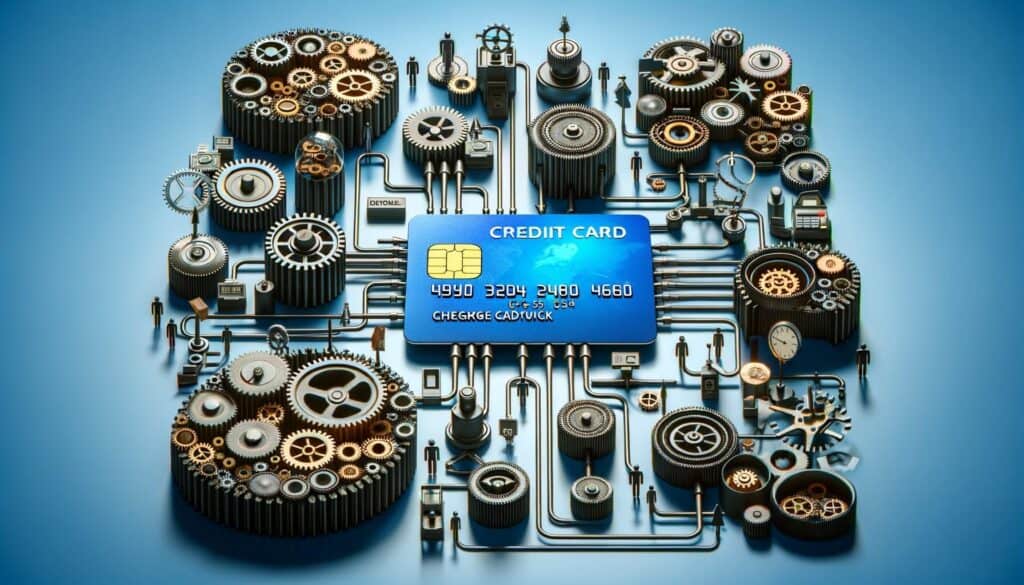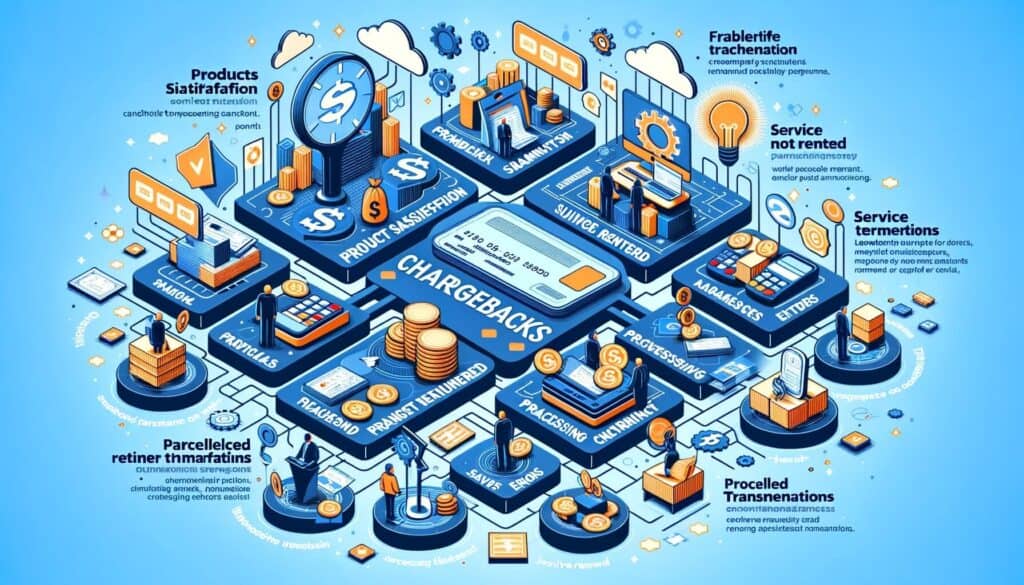
By Carol Peters March 10, 2025
In today’s digital age, online shopping has become increasingly popular. With the convenience of making purchases from the comfort of our own homes, it’s no wonder that e-commerce has experienced exponential growth. However, along with this growth comes the risk of fraudulent transactions and dissatisfied customers.
A chargeback is a process that allows consumers to dispute a transaction and request a refund from their bank or credit card issuer. It serves as a form of consumer protection, providing a safety net for buyers who have been victims of fraud, received damaged goods, or experienced other issues with their purchases. Understanding the basics of chargebacks is crucial for both consumers and merchants alike.
The Definition of a Chargeback: What Does it Mean?

A chargeback is a transaction reversal initiated by the cardholder’s bank or credit card issuer. It allows consumers to dispute a charge and request a refund directly from their financial institution. When a chargeback is initiated, the funds are taken from the merchant’s account and returned to the cardholder, effectively reversing the transaction.
Chargebacks are typically used as a last resort when a consumer is unable to resolve an issue with the merchant directly. They provide a means for consumers to protect themselves from fraudulent or unauthorized transactions, as well as to seek recourse for unsatisfactory purchases.
How Chargebacks Work: A Step-by-Step Explanation

The chargeback process involves several steps, each with its own set of requirements and timelines. Understanding how chargebacks work is essential for both consumers and merchants to navigate the process effectively.
Step 1: Dispute Initiation
The chargeback process begins when a cardholder contacts their bank or credit card issuer to dispute a transaction. The cardholder must provide a valid reason for the dispute, such as fraud, non-receipt of goods, or dissatisfaction with the product or service.
Step 2: Bank Investigation
Upon receiving a chargeback request, the cardholder’s bank or credit card issuer initiates an investigation. They gather relevant information from both the cardholder and the merchant to determine the validity of the dispute. This may include reviewing transaction records, communication between the parties, and any supporting documentation.
Step 3: Provisional Credit
During the investigation, the cardholder may be issued a provisional credit, which is a temporary refund of the disputed amount. This is done to provide immediate relief to the consumer while the investigation is ongoing. However, it’s important to note that provisional credits are subject to reversal if the chargeback is ultimately found to be invalid.
Step 4: Merchant Response
Once the merchant is notified of the chargeback, they have the opportunity to respond to the dispute. They can provide evidence to support their case, such as proof of delivery, communication records, or evidence of a valid transaction. It’s crucial for merchants to respond promptly and provide compelling evidence to increase their chances of winning the chargeback.
Step 5: Final Decision
After reviewing all the evidence, the cardholder’s bank or credit card issuer makes a final decision regarding the chargeback. If the chargeback is deemed valid, the funds are permanently taken from the merchant’s account and returned to the cardholder. If the chargeback is found to be invalid, the provisional credit is reversed, and the funds are returned to the merchant.
Common Reasons for Chargebacks: Understanding the Causes

Chargebacks can occur for a variety of reasons, ranging from fraudulent transactions to customer dissatisfaction. Understanding the common causes of chargebacks is essential for both consumers and merchants to prevent and address these issues effectively.
1. Fraudulent Transactions
One of the most common reasons for chargebacks is fraudulent activity. This can include unauthorized transactions made using stolen credit card information or identity theft. Consumers who notice unfamiliar charges on their statements are likely to initiate a chargeback to protect themselves from financial loss.
2. Non-Delivery of Goods or Services
Another common cause of chargebacks is the non-delivery of goods or services. If a consumer pays for a product or service but does not receive it within the agreed-upon timeframe, they may initiate a chargeback to obtain a refund.
3. Defective or Damaged Goods
Consumers have the right to receive products that are in good working condition and free from defects. If a consumer receives damaged or defective goods, they may initiate a chargeback to seek a refund or replacement.
4. Unauthorized Transactions
Chargebacks can also occur when a consumer notices unauthorized transactions on their account. This can happen when their credit card information is stolen or when someone makes purchases without their consent. In such cases, consumers have the right to dispute these charges and request a chargeback.
5. Dissatisfaction with Product or Service
Sometimes, consumers may initiate chargebacks due to dissatisfaction with a product or service. This can include receiving an item that does not match the description, poor customer service, or failure to meet expectations. While chargebacks should not be used as a means to obtain a refund for buyer’s remorse, legitimate cases of dissatisfaction can warrant a chargeback.
How to Dispute a Chargeback: A Comprehensive Guide

Disputing a chargeback can be a complex and time-consuming process. However, it’s crucial for merchants to understand how to effectively dispute chargebacks to protect their businesses and minimize financial losses. Here is a comprehensive guide on how to dispute a chargeback.
1. Gather Evidence
The first step in disputing a chargeback is to gather all relevant evidence to support your case. This may include transaction records, proof of delivery, communication with the customer, and any other documentation that proves the validity of the transaction.
2. Review the Chargeback Reason Code
Each chargeback is assigned a reason code that indicates the basis for the dispute. It’s important to review the reason code carefully to understand the specific allegations made by the cardholder. This will help you tailor your response and provide relevant evidence to counter the claims.
3. Craft a Compelling Response
Once you have gathered all the necessary evidence, it’s time to craft a compelling response to the chargeback. Clearly explain your side of the story, providing detailed information and supporting documentation to refute the cardholder’s claims. Be concise, professional, and persuasive in your response.
4. Submit the Response
After preparing your response, submit it to the appropriate entity, such as the cardholder’s bank or credit card issuer. Follow the specified guidelines and deadlines for submitting the response to ensure it is considered in the chargeback investigation.
5. Monitor the Chargeback Status
Once your response has been submitted, it’s important to monitor the chargeback status closely. Stay in communication with the relevant parties and provide any additional information or documentation as requested. This will help ensure that your response is thoroughly reviewed and considered in the final decision.
The Chargeback Process: From Initiation to Resolution
The chargeback process involves several stages, each with its own set of requirements and timelines. Understanding the various steps in the chargeback process is crucial for both consumers and merchants to navigate the system effectively.
1. Chargeback Initiation
The chargeback process begins when a cardholder contacts their bank or credit card issuer to dispute a transaction. The cardholder must provide a valid reason for the dispute, such as fraud, non-receipt of goods, or dissatisfaction with the product or service.
2. Bank Investigation
Upon receiving a chargeback request, the cardholder’s bank or credit card issuer initiates an investigation. They gather relevant information from both the cardholder and the merchant to determine the validity of the dispute. This may include reviewing transaction records, communication between the parties, and any supporting documentation.
3. Provisional Credit
During the investigation, the cardholder may be issued a provisional credit, which is a temporary refund of the disputed amount. This is done to provide immediate relief to the consumer while the investigation is ongoing. However, it’s important to note that provisional credits are subject to reversal if the chargeback is ultimately found to be invalid.
4. Merchant Response
Once the merchant is notified of the chargeback, they have the opportunity to respond to the dispute. They can provide evidence to support their case, such as proof of delivery, communication records, or evidence of a valid transaction. It’s crucial for merchants to respond promptly and provide compelling evidence to increase their chances of winning the chargeback.
5. Final Decision
After reviewing all the evidence, the cardholder’s bank or credit card issuer makes a final decision regarding the chargeback. If the chargeback is deemed valid, the funds are permanently taken from the merchant’s account and returned to the cardholder. If the chargeback is found to be invalid, the provisional credit is reversed, and the funds are returned to the merchant.
Chargeback Rights and Regulations: Know Your Consumer Protections
Consumers have certain rights and protections when it comes to chargebacks. Understanding these rights is crucial for consumers to navigate the chargeback process effectively and seek recourse for fraudulent or unsatisfactory transactions.
1. Fair Credit Billing Act (FCBA)
The Fair Credit Billing Act (FCBA) is a federal law that provides consumer protections for credit card transactions. Under the FCBA, consumers have the right to dispute billing errors, including unauthorized charges, charges for goods or services not received, and charges for goods or services that were not as described.
2. Electronic Fund Transfer Act (EFTA)
The Electronic Fund Transfer Act (EFTA) is another federal law that provides consumer protections for electronic fund transfers, including debit card transactions. Under the EFTA, consumers have the right to dispute unauthorized transactions and errors in electronic fund transfers.
3. Card Network Rules
Card networks, such as Visa, Mastercard, and American Express, have their own set of rules and regulations regarding chargebacks. These rules outline the rights and responsibilities of both consumers and merchants in the chargeback process. It’s important for consumers to familiarize themselves with the specific rules of their card network to understand their rights and protections.
4. Chargeback Timeframes
Chargebacks must be initiated within specific timeframes, known as the chargeback timeframes. These timeframes vary depending on the reason for the chargeback and the card network involved. It’s important for consumers to be aware of these timeframes and initiate chargebacks promptly to ensure their dispute is considered.
Chargeback vs. Refund: What’s the Difference?
Chargebacks and refunds are often used interchangeably, but they are two distinct processes with different implications for both consumers and merchants. Understanding the difference between chargebacks and refunds is crucial for both parties involved.
A refund is a voluntary transaction initiated by the merchant to return funds to the consumer. It is typically done in response to a customer request for a refund due to dissatisfaction with a product or service. Refunds are a common practice in business and are often used as a means to maintain customer satisfaction and loyalty.
On the other hand, a chargeback is an involuntary transaction initiated by the consumer’s bank or credit card issuer. It is a dispute resolution mechanism that allows consumers to seek recourse for fraudulent or unsatisfactory transactions. Chargebacks are typically used as a last resort when a consumer is unable to resolve an issue with the merchant directly.
While refunds are initiated by the merchant, chargebacks are initiated by the consumer’s financial institution. Refunds are typically processed directly by the merchant, while chargebacks involve a formal investigation by the cardholder’s bank or credit card issuer.
Real-Life Examples of Chargebacks: Case Studies and Analysis
To better understand the impact and implications of chargebacks, let’s explore some real-life examples of chargebacks and analyze the outcomes.
Example 1: Fraudulent Transaction
John, a credit card holder, notices several unauthorized transactions on his credit card statement. He immediately contacts his bank to dispute the charges and requests a chargeback. The bank investigates the transactions and determines that they were indeed fraudulent. The funds are permanently taken from the merchant’s account and returned to John.
Example 2: Non-Delivery of Goods
Sarah purchases a new smartphone online and pays for expedited shipping. However, after several weeks, she still hasn’t received the phone. She contacts the merchant multiple times but receives no response. Frustrated, she initiates a chargeback to obtain a refund. The bank investigates the case and determines that Sarah did not receive the goods as promised. The funds are permanently taken from the merchant’s account and returned to Sarah.
Example 3: Dissatisfaction with Product
Emily purchases a dress online, but when it arrives, it doesn’t fit properly and the color is different from what was advertised. She contacts the merchant to request a refund, but they refuse. Feeling frustrated, she initiates a chargeback. The bank investigates the case and determines that Emily received a product that did not match the description. The funds are permanently taken from the merchant’s account and returned to Emily.
These examples highlight the importance of chargebacks as a consumer protection mechanism. They provide a means for consumers to seek recourse for fraudulent transactions, non-delivery of goods, and dissatisfaction with products or services.
FAQs
Q1: Can a chargeback be reversed?
A1: Yes, a chargeback can be reversed if it is found to be invalid. This can happen if the merchant provides compelling evidence to refute the cardholder’s claims.
Q2: How long does the chargeback process take?
A2: The chargeback process can vary in length depending on several factors, including the reason for the chargeback, the card network involved, and the complexity of the case. It can take anywhere from a few weeks to several months to reach a resolution.
Q3: Can merchants dispute chargebacks?
A3: Yes, merchants have the right to dispute chargebacks by providing evidence to support their case. However, the success of a merchant’s dispute depends on the strength of their evidence and the specific rules and regulations of the card network involved.
Q4: Are chargebacks free for consumers?
A4: Chargebacks are typically free for consumers. However, some banks or credit card issuers may charge a fee for processing chargebacks. It’s important for consumers to check with their financial institution to understand any potential fees associated with chargebacks.
Conclusion
Chargebacks play a crucial role in protecting consumers from fraudulent or unsatisfactory transactions. However, they can also have significant implications for merchants, leading to financial losses and damage to their reputation. Therefore, it is essential for both consumers and merchants to understand the chargeback process, their rights and obligations, and take proactive measures to prevent chargebacks.
For consumers, it is important to communicate with the merchant and attempt to resolve any issues before initiating a chargeback. This can help avoid unnecessary disputes and maintain a positive relationship with the merchant. Additionally, consumers should familiarize themselves with their rights and regulations to ensure a fair and efficient dispute resolution process.
For merchants, chargeback management and prevention should be a priority. Implementing robust fraud detection systems, providing excellent customer service, and maintaining accurate records can help prevent chargebacks. By addressing customer concerns promptly and effectively, merchants can minimize the occurrence of chargebacks and maintain a positive reputation.
In conclusion, chargebacks are a vital consumer protection mechanism in the modern digital landscape. Understanding the basics of chargebacks, including their definition, how they work, common reasons for their occurrence, how to dispute them, the chargeback process, consumer protections, and the difference between chargebacks and refunds, is crucial for both consumers and merchants.
By being proactive and taking appropriate measures, consumers and merchants can navigate the chargeback process effectively and ensure a fair and secure transaction environment.
